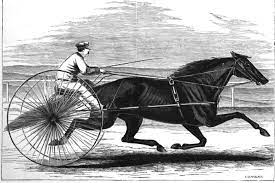Since the harness racing season is kind of in “cold storage” in North America with stakes season and our newest two-year-olds a few months away from competition and the baseball season awaiting warmer weather, as well, a recent conversation arose on just how similar our sports are when it comes to “records” and history.
 It gives this writer an opportunity to lighten up and share the history of our grand sport and why the fight continues from this corner for its future survival.
It gives this writer an opportunity to lighten up and share the history of our grand sport and why the fight continues from this corner for its future survival.
Years ago, as Senior Editor for harness racing for the new start-up Sports Information Data Base (S.I.D.B.), Phil Sporn and I had the delightful task of putting the entire history of our sport on the “internet” BEFORE it became the internet as we know it today.
We didn’t get the job totally completed when S.I.D.B. ran out of funds, but we had many a conversation with the now late Bill Shannon, V.P. of S.I.D.B. one of baseball’s human encyclopedias, and, on several occasions, we discussed “records,” he said some of which will never be broken.
He often said that Cy Young’s record of 511 lifetime wins would never be broken…or even modestly approached…or most wins in a season—that accomplished by Old Hoss Radbourn with an unbelievable 60.
And with the game changed to a point where a pitcher rarely completes a nine-inning game, the 749 complete games by Cy Young will never be challenged.
(A prop bet win on anyone breaking these records would be worth 10 times more than the biggest lottery payoff in history…maybe 1000 times, now that I think of it.)
Of course, these records, just like ones mentioned above for baseball, go back more than a century and our game has changed dramatically since then, as well.
Over the years since the first 2:00 mile was accomplished by Star Pointer in 1897 (1:59 1/4), champion after champion has whittled away—many times by just a fifth-of-a-second…and here we are, a changed sport that has become a business with the frequency of a mile that would have left Star Pointer as many as 60 or 65 lengths back.
 It’s been startling!
It’s been startling!
At the beginning of 1900, only 22 pacers had ever paced a mile under 2:05 and only three trotters—Alix, Nancy Hanks and Azote—had negotiated a mile under that same 2:05 standard.
As. for two-year-old trotters, since the horse “Doble” kicked off the “champions” list with a mile in 2:40 3/4 on October 19, 1872, at Lexington, Ky., with So So, Orient, Sweetheart, Fred Crocker, Wildflower, Sunol and Arion gradually chipping away—the latter getting within three-quarters-of-a-second off the coveted 2:10 mark in Stockton, California.
There were marks for yearlings, too, with the filly “Pride” the first on the list at 2:44 1/2 on November 5, 1881, in San Francisco with the colt Abdell knocking that down to 2:23 in San Jose, California on Sept. 27, 1894.
By the second decade of the new century—the 1900’s—the yearling colt Airdale had trotted a mile in 2:15 3/4 in 1912 with the yearling pacing colt Frank Perry pacing a mile in 2:15.
There were all sorts of records for “age,” as well with the most interesting being Goldsmith Maid’s records as a 17-year-old (2:14), 18-year-old (2:14 1/2), 19-year-old (2:14) and 20-year-old (2:14 1/2) covering the years 1874 to 1877.

The standardbred breed was one known for its durability with records kept for events to wagon and under saddle, as well as to the sulkies of the era.
In a recent Mane Attraction, the standardbred showed its remarkable durability when Alix won a nine-heat race over three days in Chicago in 1893.
Heat racing was very common in that era with many races needing four or more heats to determine a winner.
But other events featuring the standardbred breed featured the handy and docile aspect of the breed with “team-to-pole” events featuring a pair of horses hitched together. “Troikas” were also contested—three abreast—and four-in hand, as well.
One notable “troika” event occurred in 1891 when the mares Belle Hamlin and Justina teamed up with the gelding Globe to trot a mile in 2:14.
While “Xtreme” events have been conducted on occasion in recent years in Canada, our standardbreds have records on the books for distances well past the standard distance of one mile.
Starting at the distance of four miles, in 1849, the chestnut gelding Trustee won a four-mile race in 11:06 and it took some 20 years before the mare Lady Dooley was able to knock a second off that mark.
That same year, the pacing gelding Longfellow won a four-mile event in 10:34 1/4. Dutchman and the fabled Lady Suffolk also won events at that distance—under saddle.
Longfellow came back the following year and set the standard for a five-mile race to wagon on the pace at 14:15. The black trotting gelding Pascal held the overall record for the distance at 12:45.
The record for 10 miles was set by the trotting gelding Controller when he covered the distance in 27:23 1/4 in 1878. The chestnut gelding Bill has the record for 10 miles when he trotted the distance in :58:10 in 1885.
In an interesting 20-mile list, Capt. McGowan covered that distance within 15 seconds of Bill’s time for 18 miles with the aforementioned Controller and Trustee also on the list of the top six.
Note the durability of Controller, who is on the list at five miles, 10 miles and 20 miles. Gen. Taylor got his name in the record books as this grey gelding trotted 30 miles in 1:47:59—a distance and record never challenged since that 1857 event.
The grey horse Chancellor is next on the indelible list of records having trotted 32 miles in 1:58:00.
Believe it or not…there’s more.
In 1835, the gelding Black Joke set the record for 50 miles—covering the distance in three hours and 57 minutes.
And finally…
The mare Fanny Jenks trotted 100 miles in nine hours, 38 minutes and 36 seconds to set the standard for that distance in 1845…
There’s still more…
The next year, the mare Fanny Murray attempted to put her name in the record books…failing by 2:48.
And one final note…
In 1853, the gelding Conqueror attempted to place his name in the record books forever, taking a swing at the 100-mile mark.
He did it, too, covering the distance in eight hours, 55 minutes and 53 seconds.
If you’re out of breath finishing this…well, you’re not alone.
The standardbred breed is, without a shadow of a doubt the heartiest breed of them all…certainly worth the effort to keep it alive and well forever.
“May the Horse Be With You”
by John Berry, for Harnesslink

 USA
USA Canada
Canada Australia
Australia New Zealand
New Zealand Europe
Europe UK / IRE
UK / IRE



